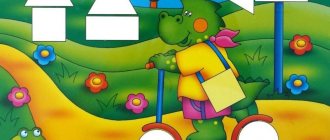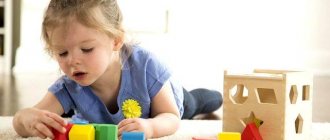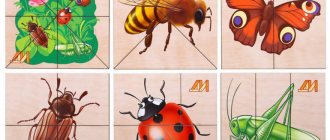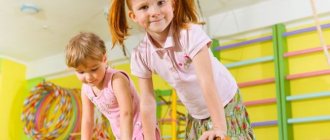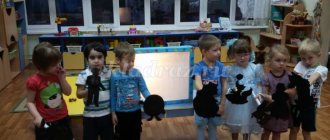Once upon a time there lived children. They ran barefoot on the grass and sand, climbed trees, swam in the stream, built sand castles, swung on swings until dark, bungee jumped into the lake, picked and ate fruits in the garden, picked mushrooms, tasted wild honey, rolled from ice mountains... How many modern children can boast of such a rich life experience?
Technological progress and the development of megacities creates a shortage of many factors that positively affect the natural development of a child. In a simple game, a small person acquires those skills and methods of processing information that subsequently serve as the basis for more complex skills and abilities, which in turn allow them to form speech and regulate behavior. Children outside of an educational institution are often deprived of a significant peer group in which imitative play can be formed. A child in a metropolis is practically deprived of full-fledged play with natural materials and gaining a base of sensory experience (for example, playing with sand, water, clay, snow, etc.). Parents cannot always allow their baby to tumble, swing, run and jump as much as natural need dictates, and not general routine moments.
Course for the development of creative thinking for children 5–8 years old Program of developmental activities for children (5–8 years old)
3000 rub
MORE DETAILS
An understanding of the mechanisms of functioning of the child’s body in natural conditions will help the teacher create an optimal developmental environment and create truly useful play activity for the child. And the ability to model them in a game setting.
Games with sensory integration elements
Goals: develop, strengthen, balance the processing of sensory stimuli by the nervous system. In the long term this is:
- development of tactile, visual, auditory, gustatory and olfactory perception;
- development of higher mental functions;
- improving motor skills;
- stimulation of cognitive activity;
- formation and development of all components of speech;
- correction and development of the emotional-volitional and communicative sphere;
- improvement of gaming, subject-practical and labor activities;
- assistance in adapting the child to new conditions.
We use a variety of materials, games and equipment that can stimulate the senses and contribute to the development of basic types of perception: perception of body position in space, tactile perception, visual, auditory, gustatory and olfactory perception.
Let's consider the equipment and technologies used in this method.
Sensory education in children 2-3 years old
In order to purposefully influence the sensory skills of preschoolers, it is necessary to know the main stages of sensory development, be able to diagnose its level and correlate it with age-related characteristics. Among them are the following:
- Getting to know an object through perception through the senses. The child puts it into his mouth, tastes it, feels it, smells it, evaluates its shape and size.
- Formation of skills to correlate the spatial arrangement of objects, connect objects and their parts. The child evaluates the sizes of objects and their relationships. To do this, you need to teach children to put one object into another (games with a pyramid work well), string beads on a cord, and push small objects into various holes. The child becomes familiar with composite objects, with the concept of the whole and parts. Games with large puzzles, cut-out pictures, and construction sets of 2-4 elements will help him with this. At the first stage, the child is able to assemble a matryoshka doll from 2 elements.
- Mastering ways to practically distinguish the properties of objects. A preschooler learns to compare two similar objects through practical actions: putting one on top of the other, the relationship between shape and color. At the second stage, the child is able to assemble a matryoshka doll from 3 elements.
- Formation of manipulative actions with an object based on repeated repetition. After practical manipulations with an object, the child is able to visually correlate the size and shape of objects using only mental operations. He can group objects according to one characteristic, select 3 objects according to a given pattern, and is able to sort objects from smallest to largest. At this stage, the preschooler assembles a five-seater nesting doll.
- Complicating the conditions for performing actions that require correlation according to one of the characteristics. The child groups objects according to several characteristics, is able to correlate 6 or more colors with each other, and visually selects a pair of objects according to given characteristics.
- Using learned actions in solving practical and cognitive problems. The child is able to reproduce acquired knowledge and skills, differentiate the properties of objects, and apply subject standards in solving assigned problems. At this stage, a 3-year-old child can correctly assemble a pyramid of 8 rings in descending order of their size.
Sensory education is a targeted didactic impact on the sensory systems of preschool children, which becomes more complex with each new stage of sensory development. Creating conditions for the comprehensive development of the senses is the task of parents and teachers of preschool educational and developmental institutions.
Gravity perception (perception of position in space) can be developed using:
- swings of various modifications, on which you can swing in different positions;
- hammocks made of lycra, creating a tight-fitting effect and just hammocks;
- swing-nest where you can hide, swinging on a sheet (game “Sea”);
- balance boards, inflatable balance beams;
- fitballs of large diameter (made of non-slip material);
- paths made of ropes, “bumps”, low swinging boards, along which you need to walk while maintaining balance;
- straight, spiral, flat and tube-shaped slides, homemade from soft modules;
- trampolines;
- tunnels, mats you can crawl under;
- group activities with a silk multi-colored parachute (round dance “inflate a bubble”, hide and seek, running, diving under it, completing a task while it is in the air, dividing the task according to the color of the segment under which the child is located).
Someone will say that the necessary material base is not available everywhere, but any equipment can be replaced with something similar or having a similar effect. The main thing is the active participation and control on the part of an adult over the implementation and safety of the game. So, for example, instead of a hammock, a sheet can be used (ours has nautical motifs) on which we swing the child. We came up with a game by reworking the famous ancient text “The sea is troubled once.” Rocking the child in the sheet (with the help of two adults and a team of little helpers waiting for their turn), we rhythmically say, forcing the sound to the climax: “The sea is worried once, the sea is worried two, the sea is worried three (pause) ... Vanya, come to us! Glug, glug, glug…” and actively shake the baby in the sheet. And then carefully lower it onto the mat or carpet (be sure to put your feet first).
Education
Elena Yurievna Petrova
Author's program
Emotional disorders in children. Methods of psychological correction
Participate
This exercise usually ends the psychologist’s work in a circle. Children perceive it as relaxation and a reward for completing tasks. The game allows you not only to feel your body in an unusual position, but also to clearly feel the time interval of the impact due to the measured constant text and the highlighting of the culmination of the exercise in your voice. Children are also well involved in the game through imitation and the desire to follow a friend. Taking turns is excellent, and for those who find the gravitational experience difficult, all this allows them to overcome anxiety.
A set of didactic games on sensory development for young children
A set of didactic games for sensory development
for younger children
"Big and small dolls."
Target:
distinguish and name objects by size.
Material:
dolls, a table, a chair, large dishes and the same objects - small ones.
Children sit on chairs in a semicircle, the teacher sits opposite, at the children's table. The teacher places a large doll table and chair on the table on the right and seats a large doll, and small furniture on the left and seats a small doll. After this, he turns to the children: “This is a big doll, and this is a small one. A large doll sits on a large chair near a large table. The big doll's name is Masha, and the little doll's name is Katya. “Why did they sit down at the table, Sasha? It's probably time for them to have breakfast. Ask Masha and Katya, did they wash their hands? They say that they washed their hands. We'll tie napkins for them and feed them. Nina, come to me (shows two plates - a large and a small one.) Which plate will we feed Masha from? And Katya? That's right, Masha is big, we will feed her from a large plate, put a large plate in front of her, and Katya is small, put a small plate in front of her. Then the teacher gives the children spoons (large and small) and asks them to give the large doll a large spoon, and the small doll a small spoon.
"Circle, square."
Material:
five cardboard circles and squares of the same color.
The teacher shows the children geometric shapes randomly mixed on the table. Then he says: “This is a circle. This is a square. I will put the circle on a round plate, the square on a square plate.” Next, the teacher invites the children to put the figures in their places and activates the children’s speech with questions: “What is this?” (Circle) “And this?” (Square), etc.
“Touch and guess.”
Target:
identify by touch and name familiar objects by shape.
Various voluminous toys or small objects are laid out on the table (rattle, ball, cube, comb, toothbrush, etc., which are covered on top with a thin, but dense and opaque napkin. The child is asked to identify the objects by touch through the napkin and name them.
"Fruit picking"
Target:
develop children's eye when choosing objects of a certain size based on a model
Material:
apples - samples (cut out of cardboard of three sizes - large, smaller, small; three baskets - large, smaller, small; a tree with hanging cardboard apples of the same sizes as the samples (8-10 apples of each size).
Progress of the game:
The teacher shows the children a tree with apples, baskets, and says that small apples should be collected in a small basket, medium ones - in a medium basket, and large ones - in a large basket. At the same time he calls three children, gives each one a sample apple and invites them to “pick” one of the same apples from the tree. If the apples are “picked” correctly, the teacher asks to put them in the appropriate baskets. Then a new group of children completes the task. If all the apples have been collected and placed in baskets, but the children show interest in the game, the apples are hung again and the game continues.
"Handkerchief for a doll."
Target:
identifying objects by the texture of the material, in this case determining the type of fabric.
Children are offered three dolls in different scarves (silk, wool, knitted). Children take turns examining and feeling all the handkerchiefs. Then the handkerchiefs are removed and placed in a bag. Children find the right handkerchief for each doll by touch in the bag.
“What figures does the machine consist of?”
Target:
identifying objects by shape.
Children must determine from the drawing what geometric shapes are included in the design of the machine, how many squares, circles, etc. it contains.
“Light the flashlight.”
Target:
to train children in distinguishing the color of an object by name, to teach them to perform game actions in accordance with the content and rules of the game.
Colored lanterns (primary colors) are placed in different places in the group room. The teacher tells the children that they will play the game “Light a Flashlight”. Showing a flashlight, he suggests looking for the same ones in the room. Everyone must find one flashlight and, going up to the teacher, say what color it is. This is the first rule of the game. When the lanterns are collected, the teacher introduces a new rule: “When I ask you to light the red lanterns, those who have red lanterns will raise them high, as if they are lighting them. And we will all look at the red lanterns. When I ask you to light blue lanterns, those with blue lanterns will light them. In this way, lanterns of all colors will gradually light up.” Before the end of the game, the teacher asks the question: “And if I ask all the children to light the lanterns, what should I do?” All the children raise their lanterns. “There are so many beautiful colored lanterns!” - says the teacher, summing up different colors in one word - colored.
“Compare objects by height.”
Target:
Determine objects by height.
Material:
trees of different heights.
Name objects, highlight high, low; compare - what is higher, what is lower.
"Recognize the figure."
Target:
develop tactile sensations.
Geometric shapes identical to those in the bag are laid out on the table. The teacher shows any figure and asks the child to take the same one out of the bag.
“What can be heard and where?”
Target:
practice orientation in space.
Children form a circle or stand with their backs to the teacher. The teacher rings the bell and asks: “Where does the bell ring?” Children indicate the direction. The teacher calls it with the words: “The bell is ringing from the right.” Then he changes the source and direction of the sound and asks again: “In which direction did the horn play? Which side did the drum play?” etc.
"The longest, the shortest."
Target:
identify objects by size.
Lay out multi-colored ribbons of different lengths from shortest to longest. Name the ribbons by length: which is the longest, which is the shortest, longer, shorter, focusing on color.
Options:
— compare ribbons according to several criteria (length and width, width and color, etc.). For example: “the green ribbon is the longest and narrowest, and the red ribbon is short and wide.”
“Place a bouquet of flowers in a vase.”
Target:
learn to group objects by color.
Material:
four vases of yellow, red, green and blue, paper flowers of the same colors.
The teacher shows the children flowers that are lying on the table, randomly mixed, and offers to collect bouquets from them and put them in vases. Then, the teacher takes, for example, a red flower and places it in a red vase, emphasizing that the flower is the same color as the vase. The teacher does the same with flowers of other colors. Next, children are invited to collect bouquets.
"Merry men."
Target:
teach children to group objects by shape.
Material: circle, square, triangle, rectangle cut out of cardboard - houses and the same small geometric shapes - people.
The teacher, together with the children, examines small geometric shapes randomly lying on the table and says that these are funny people. Then he shows, for example, a circle and says: “This little man’s name is a circle. What is the little man's name? (Circle). Show me what other little people are called circles?” Children show circles. Children also show other geometric shapes. The teacher says that the little men are lost and invites the children to help the little men find their houses. Then he explains that circle men live in a round house (puts the man on a large circle, square men live in a square house (puts the man on a large square), etc.
This game is played first using two geometric shapes, then three or four.
“Find out who lives in the house.”
Target:
teach children to understand the voices of animals.
The teacher divides the children into groups, each group depicts a familiar animal. Children sit on chairs that make up a circle - a house. One child approaches the house, knocks with a stick and asks: “Who lives in the house?” Children sitting in the house respond with sounds characteristic of a particular animal: croaking like frogs, cackling like geese, etc. The questioner must guess who lives in the house.
"Pyramid".
Target:
learn to correlate the size of rings in a given sequence.
Material:
pyramid.
Children sit at a common table, and each receives a pyramid. The teacher, sitting at the table with the children, invites them to play with the pyramids. “Here are the pyramids. They stand and look at you. The pyramids were tired of standing, they wanted to lie down. Let's help the pyramids rest? - the teacher asks the children and suggests, following his example, to remove the caps from their pyramids and place them closer to themselves. “What kind of ring does the pyramid have at the top, big or small?” Everyone takes off the smallest ring and moves it to their cap. The lying pyramid is laid out vertically from the edge of the table to the center, where a colored cardboard circle is located. When all the rings from the pyramids have been removed and laid out on the table in order of increasing size, the teacher shows how to trim a row of rings to create a beautiful, even beam. These actions allow children to feel with their hands the gradual change in the size of the rings.
A colored pattern is formed on the table in the form of rays that extend from the center of the circle and taper at the edges of the table. After admiring this pattern with the children, the teacher says: “Where are our pyramids? Look, all that's left of them are chopsticks and coasters. Tired of sticks standing naked. Let’s call the rings home and put up the pyramids again, as before.” Now the children are faced with a new task - to assemble a pyramid. “Which ring will the wand call first? - asks the teacher. “Look carefully at how the pyramid lies, and remember what ring the pyramid has at the very bottom.” The teacher either approves or corrects the children’s answers. Children choose the largest rings and put them on sticks. “Now which ring will the sticks call? - the teacher asks and, if necessary, gives hints. “A big ring, but a little smaller than the first one, go home.” Children put rings on sticks.
"Geometric Lotto"
Target:
teach children to compare the shape of the depicted object with geometric figures and select objects according to a geometric pattern.
Material:
5 cards depicting geometric shapes (circle, square, triangle, rectangle, oval, 5 cards each depicting objects of different shapes.
Progress of the game:
The teacher reviews the material with the children. Children name figures and objects. Then, according to the instructions of the teacher, they select cards with images of objects of the desired shape for their geometric samples. The teacher helps children correctly name the shape of objects (round, square, rectangular, oval, triangular). Five children take part in the game. The winner is the one who matches all the cards to the geometric pattern faster.
"Mittens".
Target:
match objects by color.
The children sit down at the table. They are given mittens with different patterns and different colors. You need to select pairs by color and patterns or other decorations (stripes, circles, squares).
"Gather the Harvest"
Goal: to develop motor skills of the fingers through actions with objects, to distinguish and name colors. Fix the button fastening method.
The teacher invites the children to harvest apples, unfasten the leaves, remove the apples (unfasten the Velcro).
"Finger dry pool"
Dry pool - used for simultaneous active stimulation on various points of the hands, fingers, palms; sensorimotor development, the formation of basic sensory standards: shape, size, material, weight, sound; fostering perseverance and patience in work; relieving emotional stress. It’s very simple to make: fill the Kinder Surprise capsules with various fillings (rice, peas, beans), cover them with thermal film for Easter eggs, put them in a small deep plastic container, and hide the Kinder Surprise toys at the bottom.
Ask your baby to look for various small objects or toys in the dry pool. By plunging as deeply as possible into the filler, the child’s hands are massaged, the fingers become more sensitive, and their movements become coordinated.
This manual can be used in music classes.
"Place the eggs in your houses"
Goals:
develop the ability to distinguish and correctly name the 4 primary colors; learn to combine a testicle with a cell, perform correlating actions (color guide); act purposefully, sequentially: from left to right, without skipping cells; develop fine motor skills of the fingers.
Description of the manual:
We paint the cells of the egg container with the main colors and varnish them. We tie the Kinder Surprise capsules in the appropriate color.
The result is a bright and beautiful manual.
Children must arrange the eggs into houses according to their color.
If possible, name the color of the eggs and the color of the houses.
"Tactile Box"
Tactile box
is a didactic manual intended for young children.
Made from an ordinary shoe box, beautifully decorated with self-adhesive paper.
The box is filled with pieces of fabric of different textures: wool, fur, silk, guipure, etc. It also contains small objects: pebbles, soft toys, ribbons, zippers, laces, etc.
Children examine all the objects in the box with great interest with their hands.
Didactic manual “Tactile box”
Helps children, using touch, explore the world around them from a completely unusual point of view.
To ensure that kids don’t lose interest in the box -
From time to time you have to update the contents of the box and come up with different fillers.
Tactile box
can be filled with objects that have completely opposite properties, for example: sandpaper, an iron key, pieces of foam rubber, a porcelain figurine, etc.
This manual can be used in direct educational activities, as well as in children’s independent activities (provided that it contains items that are safe for the life and health of children).
“Feed the piglet” with your own hands
Remedy: a soft toy (pig) and a bottle the size of the soft toy. Get mixed feed - beans, peas, corn flakes, etc.
"Fun Bucket"
Sometimes it happens that toys have already lost their meaning for the child or he has lost interest in playing with them. And then they just get scattered and constantly get underfoot. Or there are so many of these toys that it takes a long time to collect them. You can give these items new life. Didactic manual “Fun Bucket”. For it you will need a large plastic bucket, cubes of 4 colors, balls from a dry pool, also 4 colors, in order to withstand the didactic task of reinforcing the names of the primary colors. In the lid we select 4 sectors according to the main colors, cut out squares, and cut out a circle in the middle. We make 2 round holes in the side of the bucket for a child’s hand, and sew on the sweater sleeves.
By playing with this manual, the following tasks are solved:
-correlating the color of an object with a color field.
-correlation of the shape of an object with a hole.
-development of speech through words denoting the colors and shapes of objects.
-develop the ability to find objects by touch.
-development of fine motor skills and coordination.
"Let's dress up the sun"
Target:
development of sensory perception, formation of visual-motor coordination based on actions with objects.
Objectives:
To consolidate children’s ideas about colors and their shades, the ability to group objects by color, learn to compare objects by color by applying them to each other, to form hand-eye coordination based on actions with objects, to introduce the concepts of “such”, “not” such”, “same”, “different”. Cultivate friendly relationships between children, the ability to play collectively. Develop fine motor skills of the hands.
Game options:
Option No. 1 “The sun smiled.” Children lay out a sun with the image of “open eyes”. The adult invites all the children to stand in a circle, hold hands and smile at the sun and at each other.
Option No. 2 “Let’s dress up the sun.” An adult or children place an image of the sun with “open eyes” in the center of the table. Children are invited to “dress up the sun,” that is, by applying it to the main sun, the child places the rays in a circle. Next, the child needs to find a bow that matches the color and decorate the ray by applying it.
Option number 3 “The sun fell asleep.” An adult or child turns the sun over to the reverse side, i.e. with the image of “closed eyes”, and invites the children to hide the rays and bows in a “house” (a beautiful box), while naming a color they are familiar with. For example, a red ray and a red bow hid in a “house”. The game is considered finished when all the rays and bows are hidden in the house.
6
To develop tactile perception you can use:
- a pool with water and all kinds of devices for pouring, squeezing, spraying, changing the properties of water and decorating the bottom and “shores” of the pool;
- jars with water and decor for viewing and manipulating;
- tactile panels made of different materials (leather, fur, feathers, wool, etc.);
- tactile bags and tracks;
- sensory boxes - containers with various fillers (sand, cereals, grass, pebbles, as well as beads, hydrogel, fabrics, ribbons, threads, etc.);
- large cones like massage balls of different diameters;
- materials for modeling and modeling (clay, plasticine, salt dough);
- natural materials for creating compositions and fairy tales;
- sorters with various fillings.
Most often, the creation of these manuals is the work of teachers, and at home, parents. They are simple to make, but require a lot of imagination from the creator in order to become attractive not only tactilely, but externally. By adding bright elements, we superimpose visual cues on the tactile stimulation. By using various materials and containers, we turn on auditory perception (for example, a wooden box with chestnuts and beads sounds a certain timbre).
Senior group. Senior preschool age. Children 5-6 years old
Card index of games for sensory development in the senior group Card index of games for sensory development in the senior group Time orientation games “What are we doing?”
Purpose: To consolidate the names of the parts of the day - morning, afternoon, evening, night.
How to play: Children stand in a circle. The teacher invites the children to show what they do in the morning.
Playing... Games using the sensory-motor box in the older group
The guys from the group "Dolphins"
discovered a new world
of sensory play . Why the sensory box : * Develops fine motor skills , tactile sensations, creative and spatial thinking, sorting and classification skills, perseverance, patience, coordination of movements and much more...

